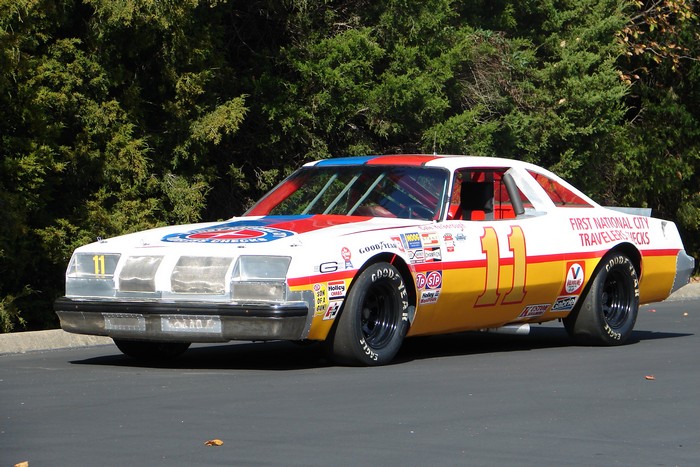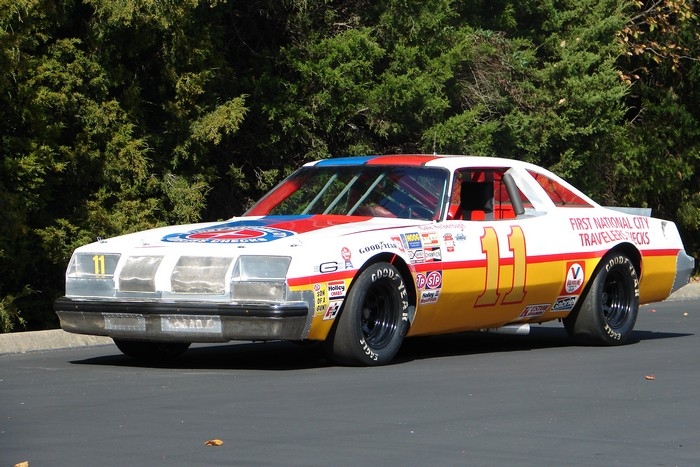
This 1977 Oldsmobile Cutlass was built by the legendary car builder Banjo Matthews for car owner Junior Johnson. Driven by three-time NASCAR champion Cale Yarborough and sponsored by First National City Travelers Checks, this car was instrumental in Yarborough winning the championship in 1978.
Legendary crew chief Travis Carter, who worked for Junior Johnson in 1978, oversaw the restoration and authenticated and certified the car in 2000. In 2004, Yarborough drove this car under the lights at Darlington Raceway to celebrate the lighting of “The Lady in Black.”
A very authentic and rare piece of racing history. Also included is a Bell Racing helmet autographed by Cale Yarborough.
(Introductory description courtesy of Barrett-Jackson.)
SCM Analysis
Detailing
| Vehicle: | 1977 Oldsmobile Cutlass NASCAR race car |
| Years Produced: | 1977 |
| Number Produced: | Unknown |
| Original List Price: | N/A |
| SCM Valuation: | $20k–$30k |
| Tune Up Cost: | $300 |
| Distributor Caps: | $20 |
| Chassis Number Location: | N/A |
| Engine Number Location: | N/A |
| Club Info: | Historic Stock Car Racing Series |
| Website: | www.hscrs.com |
| Alternatives: | Any vintage NASCAR racer from 1970–80 |
| Investment Grade: | C |
This Oldsmobile racer, Lot 707, sold for $22,000, including buyer’s premium, at Barrett-Jackson’s Scottsdale sale on January 13–20, 2012.
If Formula One is the Dom Perignon of the racing world, then NASCAR is certainly the Budweiser. A once-brash, refreshing, and purely American brand, NASCAR has become a global icon held up by the hardworking everyman.
Although NASCAR isn’t exactly my cup of sweet tea, my appreciation of 700-horsepower small-blocks and three-wide racing runs deep. But the era of the “Car of Tomorrow” and, heaven help us, fuel injection, has lost its grip on me.
From dirt tracks to big business
It’s not that I don’t respect the drivers, and it’s not that I don’t lust for the machines; it’s just that it all seems too polished. Drivers have traded their cigars for smoothies, crew chiefs are rarely caught in the gray anymore, and the slightest bit of rubbin’ lights up the Twittersphere. If Harry Hogge was Kurt Busch’s man behind the wall, he probably wouldn’t hesitate to remind the talented hothead that “Rubbin’, son, is racin’.”
I grew up eating hot dogs and inhaling fumes at the appropriately named Dixie Speedway, a 3/8-mile dirt oval that could be heard from my bedroom on hot, summer Saturdays. There were no hairpins or corkscrews, no pretty ladies in fancy hats, and no prancing ponies. There was, however, an overabundance of testosterone and cheap horsepower.
That slick, red-clay surface had the power to reduce the machine to the sideshow, simply an implement to be wielded at the very edge of control. It was the drivers’ stage, and every challenge, every pass, and every mistake was on display for all to see.
It was the fans’ connection to the drivers and their grit as racers that propelled stock car racing to a national pastime. Legions of underdogs were cheering the greasy-fingernailed, rough-around-the-collar local boys who fought their way onto the national stage, and the bigger the underdog, the better.
There’s no denying that the sport isn’t what it used to be, and, to be honest, most of the “improvements” have been just that. But the road from Dixie to Daytona seems much longer today than it used to be.
Grit, championships and blue-collar legends
As a general fan of hot-dogging, fist fighting and good ol’ boys, I just can’t help but think that this car somehow slipped through the cracks in Scottsdale.
Cale Yarborough was not an “also-ran.” Only four other drivers have matched his total of three stock car championships, and only four others have bested him. All eight of those men are racing legends in their own right, but until Jimmie Johnson won his unprecedented fifth straight NASCAR championship just a couple of years ago, Cale Yarborough was the only man to string together three championships in a row. He was also a member of the first class of nominees for the NASCAR Hall of Fame, and was one of only five members inducted in the Hall’s third class.
Despite all the checkered flags and gold cups, Cale is probably best remembered for what took place on the Daytona infield in 1979. In one of the most notorious collisions in NASCAR history, Donnie Allison and Cale Yarborough smashed each other out of contention for the race win under the white flag, and handed Richard Petty his sixth Daytona 500 victory in the process.
To the delight of thousands of fans across the country, the two Southern boys got out of their cars and kept fighting. As Petty strutted by on his victory lap, Cale and Donnie were tangled up in the mud with helmets and fists a-flyin’. That moment, televised to the world, cemented NASCAR’s hold as the blue-collar sport of choice, and helped spark its meteoric rise in popularity.
As if Cale’s performances on the track and the infield weren’t enough, the man starred in not one, but two episodes of “The Dukes of Hazzard,” both of which sported his name in the title. If that’s not a legacy, I don’t know what is.
A great buy
According to the sale literature, this car played an important role in Cale’s championship in ’78, and was authenticated by Travis Carter, one of the most traveled crew chiefs in NASCAR history. The fact that the former car owner was Junior Johnson, the moonshiner who happened to be the winningest driver to never win a championship, is just the icing on the cake.
So how in the world did this car roll off the block for a drop in the bucket? Colin Comer’s “Collecting Ricky Bobby” piece in ACC’s May-June 2012 issue (p. 48) outlines a few of the tremendous advantages of owning a retired NASCAR racer, but he may also have shed a little light on why Yarborough’s legacy seems to have had little impact here. Colin points out that access to historic racing venues abounds for stock cars, their safety equipment is second to none, and the quality of engineering and availability of parts makes owning and operating a roundy-round racer as easy on the wallet as it is on the psyche.
What this all points to in terms of collecting is that the cars themselves really aren’t all that special. Used-up racers are retired by the bunches, and in an effort to produce parity for the sport, NASCAR has forced a herd of clones upon us. Although Cale’s car was built and raced at the end of what most people consider the “stock” era of stock car racing, the Olds certainly can’t be considered unique. It is simply one of the many thoroughbreds Mr. Yarborough has managed to put out to pasture.
Despite that fact, I think our buyer here got a whole lot of car and a heapin’ helpin’ of legacy for a cut-rate price. This is an absolutely usable, near bullet-proof piece of racing history that was had cheap enough to enjoy at full song at the track, or as a polished shrine to one of the sport’s all-time greats. That being said, this may have been the deal of the week.
